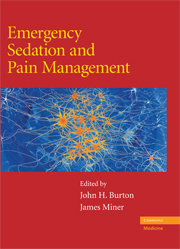Book contents
- Frontmatter
- Contents
- Acknowledgments
- List of Contributors
- SECTION ONE OVERVIEW AND PRINCIPLES IN EMERGENCY ANALGESIA AND PROCEDURAL SEDATION
- SECTION TWO ANALGESIA FOR THE EMERGENCY PATIENT
- SECTION THREE PROCEDURAL SEDATION FOR THE EMERGENCY PATIENT
- SECTION FOUR TOPICAL, LOCAL, AND REGIONAL ANESTHESIA APPROACH TO THE EMERGENCY PATIENT
- SECTION FIVE SPECIAL CONSIDERATIONS FOR EMERGENCY PROCEDURAL SEDATION AND ANALGESIA
- 37 Sedation and Analgesia for the Prehospital Emergency Medical Services Patient
- 38 Induction Agents for Rapid Sequence Intubation of the Emergency Department Patient
- 39 Sedation and Analgesia for the Critical Care Patient
- Index
- Plate section
- References
38 - Induction Agents for Rapid Sequence Intubation of the Emergency Department Patient
from SECTION FIVE - SPECIAL CONSIDERATIONS FOR EMERGENCY PROCEDURAL SEDATION AND ANALGESIA
Published online by Cambridge University Press: 03 December 2009
- Frontmatter
- Contents
- Acknowledgments
- List of Contributors
- SECTION ONE OVERVIEW AND PRINCIPLES IN EMERGENCY ANALGESIA AND PROCEDURAL SEDATION
- SECTION TWO ANALGESIA FOR THE EMERGENCY PATIENT
- SECTION THREE PROCEDURAL SEDATION FOR THE EMERGENCY PATIENT
- SECTION FOUR TOPICAL, LOCAL, AND REGIONAL ANESTHESIA APPROACH TO THE EMERGENCY PATIENT
- SECTION FIVE SPECIAL CONSIDERATIONS FOR EMERGENCY PROCEDURAL SEDATION AND ANALGESIA
- 37 Sedation and Analgesia for the Prehospital Emergency Medical Services Patient
- 38 Induction Agents for Rapid Sequence Intubation of the Emergency Department Patient
- 39 Sedation and Analgesia for the Critical Care Patient
- Index
- Plate section
- References
Summary
SCOPE OF THE PROBLEM
Rapid sequence intubation (RSI), a tool of anesthesiology for long, was rapidly adopted by the emergency physician. The emergency physician's approach necessarily differs owing to the circumstances of the most commonly encountered patients and environment. As stated by Dronen et al., “Whereas anesthesiologists use RSI to intubate patients requiring anesthesia, emergency physicians commonly use RSI to induce anesthesia in patients requiring intubation.”
Emergency physicians often do not know a patient's past medical history, medications, prior anesthetic complications, timing of the last meal, or even their clinical diagnosis. Emergency physicians must also confront emergent airway compromise with a goal to establish a stable airway in the fastest, most safe manner possible. Numerous studies support the use of sedation and paralytics in RSI to achieve a higher intubation success rate with fewer complications. Success is improved by a factor of 50–70% in some published reports when RSI methods are compared to non-RSI airway approaches.
PAIN/SEDATION CONSIDERATIONS
RSI
The process described as RSI refers to the rapid administration of medication designed to avert complications, sedate the patient, and relax the musculature to allow rapid control of the airway by tracheal intubation. The indications for airway control vary with the clinical circumstances. These agents range from the need for anesthesia for surgery to preservation of life in a respiratory emergency. The choice of RSI medications and techniques is dictated by the specific clinical scenario.
The RSI timeline varies with the individual patient circumstances.
- Type
- Chapter
- Information
- Emergency Sedation and Pain Management , pp. 260 - 267Publisher: Cambridge University PressPrint publication year: 2008



